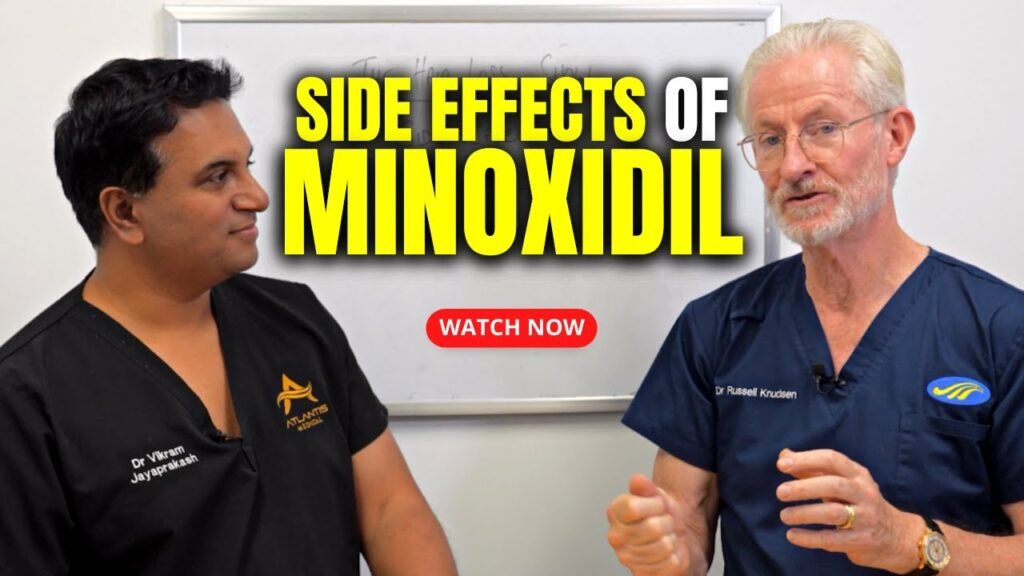Understanding Minoxidil and Its Common Side Effects
Minoxidil is a popular over-the-counter medication primarily used to treat hair loss in both men and women. Originally developed as an oral medication for high blood pressure, its hair regrowth side effect led to its topical formulation for treating androgenetic alopecia. Minoxidil works by stimulating hair follicles, potentially increasing their size and prolonging the growth phase of hair. While it has been widely accepted as an effective treatment for hair thinning, users should be aware of its potential side effects.
Common Side Effects of Minoxidil
When using minoxidil, some users may experience side effects, though they are generally mild. The most frequently reported side effect is scalp irritation, which can manifest as redness, itching, or dryness. This can often be managed by adjusting the frequency of application or switching to a different formulation, such as a foam instead of a liquid. Another common issue is unwanted facial hair growth, particularly in women, as the medication can sometimes spread beyond the intended area during application.
Systemic Side Effects
Although rare, some individuals may experience systemic side effects due to the absorption of minoxidil into the bloodstream. These can include dizziness, rapid heartbeat, or swelling of the hands and feet. Users with pre-existing heart conditions should consult with a healthcare professional before starting treatment with minoxidil. Being informed about these potential side effects helps users make educated decisions about their hair loss treatment options.
Can Minoxidil Cause Dizziness? Exploring the Connection
Minoxidil is a popular medication primarily used to treat hair loss, but like any medication, it can come with side effects. One question that often arises among users is whether minoxidil can cause dizziness. Understanding the potential link between minoxidil and dizziness is crucial for users looking to make informed decisions about their treatment options. While dizziness is not the most common side effect, it has been reported by some users, especially during the initial stages of use.
The mechanism behind this side effect can be attributed to minoxidils role as a vasodilator. Originally developed as an oral medication for high blood pressure, minoxidil works by widening blood vessels, which can lead to changes in blood pressure. When applied topically for hair loss, a small amount of minoxidil can still enter the bloodstream, potentially causing systemic effects like dizziness in sensitive individuals. This is more likely if the recommended dosage is exceeded or if the medication is applied to broken skin, which can increase absorption.
For those experiencing dizziness, its essential to monitor the symptoms closely. Users should ensure they are following the recommended application guidelines and consult a healthcare provider if dizziness persists. Its also important to consider other factors that might contribute to dizziness, such as dehydration, low blood sugar, or interactions with other medications. By understanding the potential causes, users can better manage their symptoms while continuing to benefit from minoxidils hair growth-promoting properties.
Effective Strategies to Reduce Dizziness After Using Minoxidil
Experiencing dizziness after using Minoxidil can be an unsettling side effect, but there are effective strategies to help mitigate this sensation. Firstly, its crucial to adhere to the recommended dosage. Over-application can increase the likelihood of systemic absorption, leading to dizziness. Carefully following the instructions provided by your healthcare provider or those on the product label can prevent excessive use and reduce the chances of experiencing dizziness.
Another effective strategy is to apply Minoxidil at night. By doing so, you give your body ample time to absorb the medication while you rest, potentially minimizing the immediate side effects like dizziness. Additionally, lying down after application can help manage any lightheadedness that might occur, as it allows your body to adjust without the added stress of maintaining balance.
To further reduce dizziness, consider implementing gradual changes in body position. When moving from a sitting or lying position to standing, do so slowly to give your cardiovascular system time to adapt. This can prevent sudden drops in blood pressure that may contribute to dizziness. Moreover, staying well-hydrated and maintaining a balanced diet can support overall cardiovascular health, which in turn may help mitigate dizziness associated with Minoxidil use.
Consulting with Healthcare Professionals About Minoxidil Side Effects
When considering the use of minoxidil, it is crucial to consult with healthcare professionals to fully understand the potential side effects associated with this medication. Minoxidil, primarily used for treating hair loss, can have a range of effects that vary from person to person. Speaking with a healthcare provider can provide personalized insights into how minoxidil may interact with your specific health conditions or medications. Healthcare professionals can also offer guidance on managing any side effects that may arise, ensuring a safer and more effective treatment experience.
Understanding Potential Side Effects
During a consultation, healthcare providers can explain the potential side effects of minoxidil, which may include scalp irritation, unwanted facial hair growth, or changes in hair texture. More serious side effects, although rare, could involve chest pain, rapid heartbeat, or dizziness. By discussing your medical history and any current medications with a healthcare professional, you can better understand the likelihood of experiencing these side effects and how they might impact your overall health.
Personalized Advice and Monitoring
Healthcare professionals can offer personalized advice based on your individual health profile. They may recommend starting with a lower dosage to minimize side effects or suggest alternative treatments if minoxidil is not suitable for you. Additionally, regular follow-up appointments can be scheduled to monitor your progress and address any concerns that may arise during treatment. This ongoing support ensures that any adverse reactions are promptly managed and helps in achieving the desired results safely.
Alternative Treatments for Hair Loss: Options Beyond Minoxidil
While minoxidil is a well-known solution for hair loss, there are several alternative treatments available that can offer promising results. These options range from natural remedies to advanced medical procedures, catering to individuals seeking different approaches to combat hair thinning and promote regrowth.
Natural Remedies and Supplements
Many people turn to natural remedies and dietary supplements to address hair loss. Saw palmetto, for instance, is a herbal remedy that has been linked to hair regrowth by blocking the conversion of testosterone to dihydrotestosterone (DHT), a hormone associated with hair loss. Biotin, a B-vitamin, is also popular for its potential to strengthen hair and nails. Additionally, essential oils like rosemary and peppermint have been studied for their ability to stimulate hair growth when massaged into the scalp.
Platelet-Rich Plasma (PRP) Therapy
PRP therapy is a cutting-edge treatment that has gained traction for its effectiveness in hair restoration. This procedure involves drawing a small amount of the patient’s blood, processing it to concentrate the platelets, and then injecting the platelet-rich plasma into the scalp. The growth factors in PRP are believed to stimulate hair follicles and promote natural hair growth. Many patients report seeing an improvement in hair thickness and density after undergoing PRP treatments.
Low-Level Laser Therapy (LLLT)
Low-Level Laser Therapy is another non-invasive treatment option for hair loss. This method uses lasers to emit photons into scalp tissues, which are absorbed by weak cells to encourage hair growth. LLLT is often administered through specialized devices such as laser combs or caps and can be used at home or in a clinical setting. Studies suggest that LLLT can improve hair density and strength, making it a viable option for those seeking alternatives to topical treatments like minoxidil.


